Released in 2008, Django’s main function is to take care of the hassle of web development so the programmer can focus on writing their apps using common web development codes and design patterns.
Django is a free, open-source project with an active community and precise documentation. Django has been growing and improving over the years to make it easier for programmers to build efficient websites by adding functions to support databases and various data caching operations.
Django is one of the most widely used web development frameworks. It’s used in many applications that we all use daily including Instagram, YouTube and Spotify.
What Is Django Used For?
How Does Django Work?
Any Django project consists of four main files that create the application’s core.
- URLs.py: A URL mapper file to redirect HTTP requests to the view file based on the request URL.
- View.py: A view file takes in HTTP requests and returns HTTP responses. The view file gets the data from the model file and sends the response to the template’s text file for rendering.
- Models.py: A file that defines the structure and management of the application’s data.
- Templates.html: A file that contains the web page’s layout.

When to Use Django: Advantages and Disadvantages
Django Advantages
First and foremost, Django helps developers build a complete application because the framework contains everything developers need. For example, Django offers a skeleton website you can use right away, form templates to collect data, a potent user authentication/permission system and various options to serialize XML and JSON data.
All these functionalities (and more) work together by following consistent design principles. Some of these principles are consistent with Python as a programming language, such as writing concise, readable code with no secrets in the back end. Django also operates by way of Django-specific principles like consistency, quick development/expansion of the code and DRY (don’t repeat yourself), which means every functionality should be in one place only to avoid redundancy. Together these principles make Django easier to use. Because Django is a complete framework, it also helps developers avoid common security problems (such as putting session information in the cookies).
We can use Django to build applications of all sizes, which makes it simple to scale your application. Since all Django applications follow the same design principles, the process of debugging, extending and maintaining the project is simple and systematic.
Django Disadvantages
Although Django can be a helpful, powerful framework, especially for Python programmers looking to dip their toes into the world of web development, it does have a couple of drawbacks we can’t overlook.
Django is not ideal for straightforward applications. If you want to build a simple web interface, like a landing page that doesn’t require interactions with a database or a files directory, then Django might not be the best option. Since Django is a high-level, complex framework with many features, using a significantly smaller Python web development framework like Flask would be better if your application is small.
Django is also not ideal if your application is already large and can’t exist within a single codebase. Since Django is a complete web development framework, it’s quite large, which can lead to slow speeds for the final application. So, although Django makes scaling the application fast, the process may result in an application that’s slow.
Finally, you’ll also want to avoid using Django if you want to build every part of your project from scratch to learn the basics of web development. Django does a lot of that work for you.
Is Django Easy to Learn?
Django is not easy to learn. That said, if you already know your way around Python and the basics of web development (user interactions, dealing with databases and server programming), it shouldn’t take much time to get a handle on Django. However, if Django is your first step toward learning web development, then it may be quite challenging for you to master because you’ll need to learn web development and the structure of Django at the same time.
Is Django Front End or Back End?
Django is a framework that bridges both the front end and the back end; in fact, it serves as both. Since Django is built upon Python (which we use to deal with databases and perform the back end functionalities), we can consider it a back end tool. However, Django also allows you to edit HTML files and create HTML pages, which is a front end functionality. So, Django is basically a tool that allows you to develop both the front and back ends of your application in the same place.





